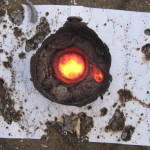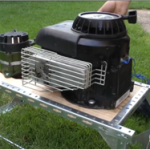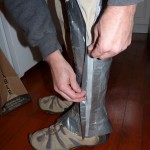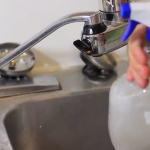Most private septic systems are made up of two parts: The holding and digesting tanks and the dispersal field. The system shown here is a small system, designed for limited use of by two people with no laundry and a small travel trailer. The concept is not the same as a larger system. The tank is much smaller than required and the design is missing some important items such as internal baffles and a qualified site assessment. This system uses two 55 gallon drums, as opposed to the 1000 to 2000 gallon tanks used for a standard home septic system. The system we are creating here also has a dispersal field about one third that of a large home.
Property owners planning a system similar to this one should be aware that this system would not pass muster with any public health department in the USA and could subject the owner to a hefty fine if the system was discovered in use.
Steps
Dig a ditch 4 feet wide, 26 feet long, and 3 feet deep.
Assemble all the supplies, parts, and equipment. See the “Things You’ll Need” list below.
Cut a hole in the top of each drum the size of the toilet flange pipe outside measurement. It should be near the edge. A saber saw is best for this task.
Attach a 4″ toilet flange to each hole.
Cut two holes in the top side of the lower drum, as shown in the photo, 45 degrees away from a perpendicular line drawn from the hole on top to the far side.
Cut one hole in the upper drum opposite the hole in the top, as shown in the photo.
Place the drum with one hole in the side at the end of the trench. Level the drum. The top of the drum should be at least 4 inches below grade.
Dig a hole about one foot deeper for the placement of the second drum in front of the first.
Dig the hole mentioned in step 8 a little deeper and fill with gravel until the 90 ell fits perfectly from the hole in the side of the top drum to the toilet flange of the lower drum.
Cut a 3 1/2″ piece of 4″ ABS pipe (nipple) and glue it into one end of the 90 ell. Cut another nipple about 2 1/2″ long and glue it in the other end.
Test the fit for alignment between the two drums. The end with the short nipple should go into the upper drum. It should look like the photo in Step 9.
When you are sure about the fit, glue the end of the 3 1/2″ nipple into the toilet flange. We will deal with sealing the connection to the upper drum later.
Glue a “Y” to 3 1/2 nipples and add a 45 degree bend to the left side of the “Y”. Align the “Y” to meet the incoming waste line, and glue it into the toilet flange.
Cut and glue (2) 2 1/2″ nipples to the remaining two 45 degree bends at one end only and insert into holes in the side of the lower drum, as shown in the photo in step 7. The face of the two 45 degree bends should be perpendicular to the trench.
See photo in Step 7
Pound a stake into the ground so that the top of the stake is level with the bottom of the 45 degree bend coming out of one side of the bottom drum.
Tape a 1″ wide block to the end of a 4 foot level, as shown in the photo to the right.
Start the second stake a little less than 4 feet down the trench from the first.
Lay the end of the level without the block on the first stake and the block on the second. Pound the stake down until the level shows level when the block is on the second stake. The second stake is now 1″ lower than the first, or 1/4″ per foot.
Repeat this process until you have stakes the length of the trench.
Place the gravel in the trench until the top of the gravel is equal with the top of the stakes.
The gravel should now slope away from the drums at 1/4″ to the foot.
Place two pieces of 10 foot 4″ perforated drain pipe connected with a slip coupler (holes down). Slide one end into the 45 degree bend of the lower drum. Repeat on the other side.
Check the drain pipes with the level and block to see if the 1/4″ grade is consistent along the length of the pipe. Adjust by adding or removing gravel under the pipe.
Seal the 45 degree bends and the 90 degree bend to the lower and upper drums, respectively. Try a two part epoxy. You could also use silicon caulk. See the photo in step 6 for finished view of epoxy. Consider using flex pipe for this, so that if the ground shifts it will give a little.
Bury the trench to the top of the bottom drum with the remaining gravel.
Lay landscape fabric over the gravel. This will prevent the soil from seeping into the gravel.
Fill the remaining trench area with soil, compacting well to the original grade.
Fill the upper drum with water.
Tips
- After a while, you may see settlement where the trench was. Fill with more soil and compact with wheel of your car. Don’t drive over the area that contains the drums.
- The digestive tanks are made of two plastic 55 gallon drums. The waste fills the first tank, with the solids falling to the bottom. When the liquid reaches the level of the outfall to the second tank, it drains into it. If any solids are there, they fall to the bottom. When the liquid from the second tank reaches the two outfalls, it travels to the gravel leaching field for dispersal. Most of the solids will liquefy over time and be dispersed. After a couple of years, the solids may come to the top of the tank, and the tank will have to be pumped out.
- It is presumed that you know how to work with plastic ABS pipe. You must also have equipment to dig the trench (or be willing to get a lot of exercise).
- The depth of the trench is relative to the depth of the waste source line. If the line is deeper or higher than the one shown, you will have to dig the trench deeper or shallower to accommodate that depth. It’s not that hard to figure. (Note: If you have too shallow of a trench, your septic system could be damaged easier.)
- The vertical side of the “Y” will be used to pump out the tank when it is completely fill with solids.
- The horizontal side of the “Y” connects to the waste source, and should be fitted with a connector that fits the source supply line.
- 30% of the waste goes down in the ground and 70% is evaporated by sunlight. Don’t compact; it messes up the evaporation process
Warning
- Local Septic Regulations should be followed when constructing a septic system. It is illegal to install a septic system with no permit, the permit will detail the local requirements for installation of a septic system.
- Don’t locate your septic system too close to trees, as tree roots will grow into your line, and cause them to clog (with roots) and with time, cause harm to your system.
- This is a very small capacity system. This is not designed to meet the needs of a large household. It is designed for a small travel trailer and two people.
- Depending on use, you may have to pump the upper drum once a year. The system shown here has been pumped twice in five years.
Things You Will Need
(2) 4″ drain pipe couplers
(2) 4″ toilet flanges
(1) 4′ Level
(10) Wood Stakes
(1) Set of PVC glue
(1) Two part epoxy or silicon sealant
(1) 1″ thick wood block
(1) Duct tape
(1) 4″ ABS removable cap for pump out when needed












































